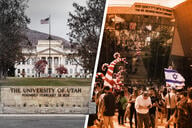You have /5 articles left.
Sign up for a free account or log in.
Despite college administrators' attempts to stamp out white supremacist activities on campuses, these often-anonymous outsiders are distributing their literature with greater frequency, according to a new Anti-Defamation League report.
The group's Center on Extremism tracks and verifies incidents involving white supremacists each academic year. It has found sustained growth in propaganda incidents on campuses in recent years.
White supremacists were more active on campuses than ever before during the spring semester, according the new analysis ADL released on Thursday. From January to May, at least 161 examples of white supremacy propaganda were recorded on 122 different campuses in 33 different states and Washington, D.C.
A total 313 cases of white supremacist materials were documented during the 2018-19 academic year. An ADL analysis earlier this year focused on white nationalist activities outside of campuses, but also included statistics on colleges that were similar to the Thursday report.
During the previous academic year, ADL found at least 292 incidents of white supremacy propaganda. Generally, white nationalists who are not connected to the university are responsible for the material.
They have been increasingly targeting colleges and universities since January 2016, and began appearing in larger numbers in the fall semester of that year, according to the ADL. More than three years later their materials -- fliers, stickers, posters -- continue to proliferate on campuses.
The posters often contain insignias and other white nationalist images and are used to direct students and others to social media. White supremacists often target campuses because they want to recruit young extremists to their ranks and to "inject their views into spaces they view as bastions of liberal thinking and left-wing indoctrination," according to the report.
As was the case previously, the main culprit of the postings this spring seems to be a group formerly (and best) known as Identity Evropa, which rebranded in March as the American Identity Movement.
The organization accounted for more than 70 percent of the white supremacist propaganda posted during this academic year, ADL said. After moving away from the Identity Evropa moniker, the group stopped posting European-focused propaganda and instead focused on advocating for the preservation of "white culture." Among its new slogans: "Defend America," "nationalism not globalism" and "diversity destroys nations."
The Southern Poverty Law Center wrote in March that no other white supremacist group has attempted to frame its views for a mainstream conservative audience more than the American Identity Movement. The SPLC considers it a hate group.
Its members downplay the extremism of their views, and advocate for immigration control in a way they believe will appeal to supporters of President Trump, the SPLC wrote. The image rehabilitation is an attempt to "cozy up to the Republican Party and, they hope, eventually alter the GOP to fit their own image," according to the SPLC.
The new leader of the American Identity Movement, Patrick Casey, who took over the group more than a year ago, and another prominent member, James Allsup, a popular "alt-right" figure on YouTube, have pushed the organization's new strategy. Its logo is similar to Patriot Front's, another white supremacist group that split from Vanguard America in 2017.
Identity Evropa has grown significantly. The Center on Extremism told Inside Higher Ed in March it believed the group (prior to the rebrand) had swelled to about 500 members nationwide, with about a third of those going on campus to post fliers and other materials.
While Patriot Front has largely moved away from colleges, it still distributed propaganda on campus about 30 times this spring.
"This data clearly demonstrates that white supremacists in the United States are emboldened by the current political and social climate," Jonathan Greenblatt, ADL's CEO and national director, said in a written statement. "Our campuses and communities should be places for learning and development, not places for racists and bigots to propagate hate speech and search for potential recruits."




